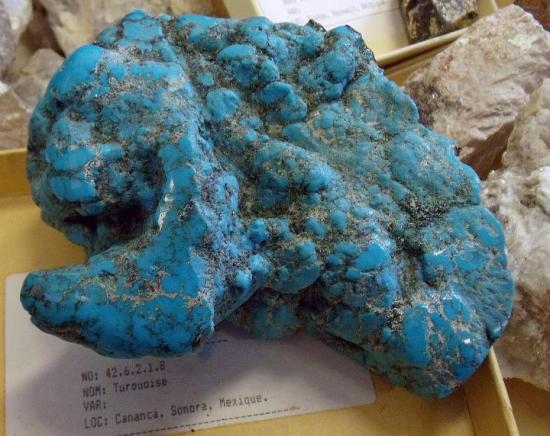GEOLOGICAL SOCIETY OF AMERICA
Source - http://www.eurekalert.org/pub_releases/2015-06/gsoa-atm061115.php?
 This is a turquoise sample from Cananea, Sonora, Mexico - Image from Wikipedia; CC BY 2.0
This is a turquoise sample from Cananea, Sonora, Mexico - Image from Wikipedia; CC BY 2.0
Turquoise has had cultural significance for Native American peoples in the southwestern United States and Mexico for more than a millennium, and turquoise artifacts have been recovered from archaeological sites hundreds of kilometers distant from known sources of the mineral. Evidence for pre-Hispanic turquoise mining has been recognized across much of the southwestern United States and northern Mexico, including as far north as Leadville, Colorado, and as far south as Zacatecas.
Detailed archaeological studies of ancient turquoise mines are rare, and little is known about the timing of their exploitation or the cultural identities of the miners In this study, Alyson M. Thibodeau and colleagues show that many geological sources of turquoise in the southwestern U.S. and northern Mexico can be distinguished from each other through the measurement of lead and strontium isotopic ratios. These isotopic analyses thus provide a new way to investigate the mining and movement of this mineral in prehistory.
Isotopic evidence for the provenance of turquoise in the southwestern United States
A.M. Thibodeau et al., Dickinson College, Carlisle, Pennsylvania, USA. Published online ahead of print on 3 June 2015; http://dx.doi.org/10.1130/B31135.1.
Abstract
The archaeological record shows that turquoise was widely mined and highly valued by pre-Hispanic societies in the southwestern United States, and it has long been assumed that much of the turquoise noted in ancient Mesoamerica was traded from this region. However, little is understood about the acquisition and exchange of turquoise by Native American societies because the geological sources of most turquoise artifacts from archaeological sites in the southwestern U.S. and Mexico are not known. We evaluate the potential for Pb and Sr isotopic ratios to indicate the geological provenance of turquoise artifacts recovered from these regions. Pb and Sr isotopic measurements were made on 137 geological samples of turquoise from 19 mining districts across the southwestern United States and northern Mexico. These data reveal that isotopic signatures of turquoise deposits vary geographically according to regional and local differences in the geologic settings of turquoise mineralization. As an archaeological case study, we also report Pb and Sr isotopic data on 10 turquoise artifacts recovered from three late pre-Hispanic (ca. A.D. 1250–1400) ancestral Zuni sites located in the El Morro Valley of western New Mexico. These have isotopic signatures uniquely consistent with the turquoise deposits of the Cerrillos Hills, a location identified in Zuni traditional history as an ancient source of turquoise. These data thus establish Pb and Sr isotopic measurements as powerful tools for determining the sources of turquoise artifacts and provide a new framework for evaluating the role of turquoise in pre-Hispanic exchange networks across North America.